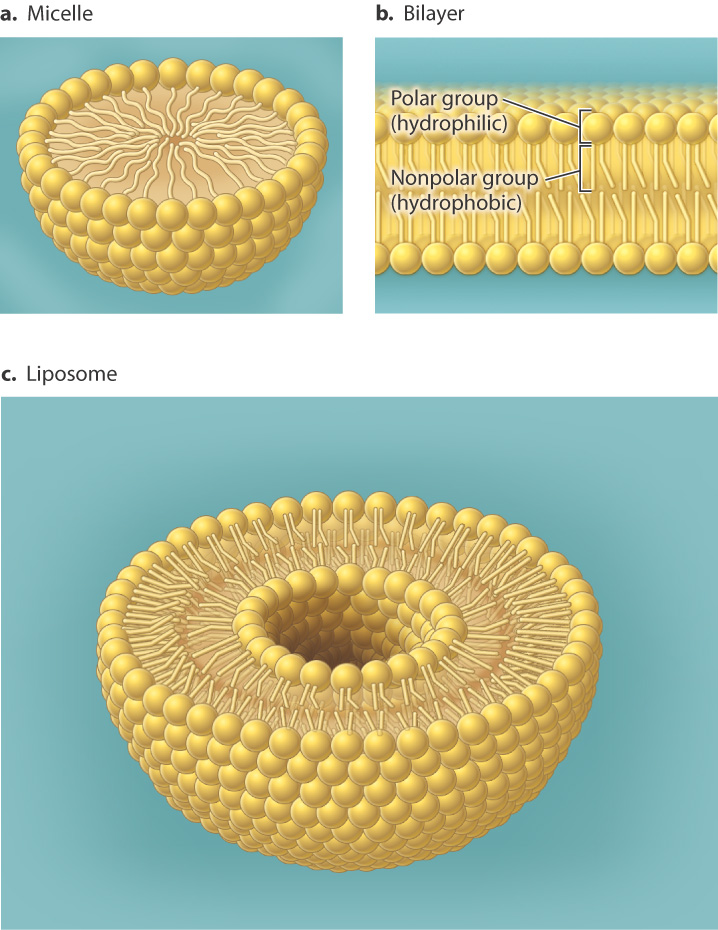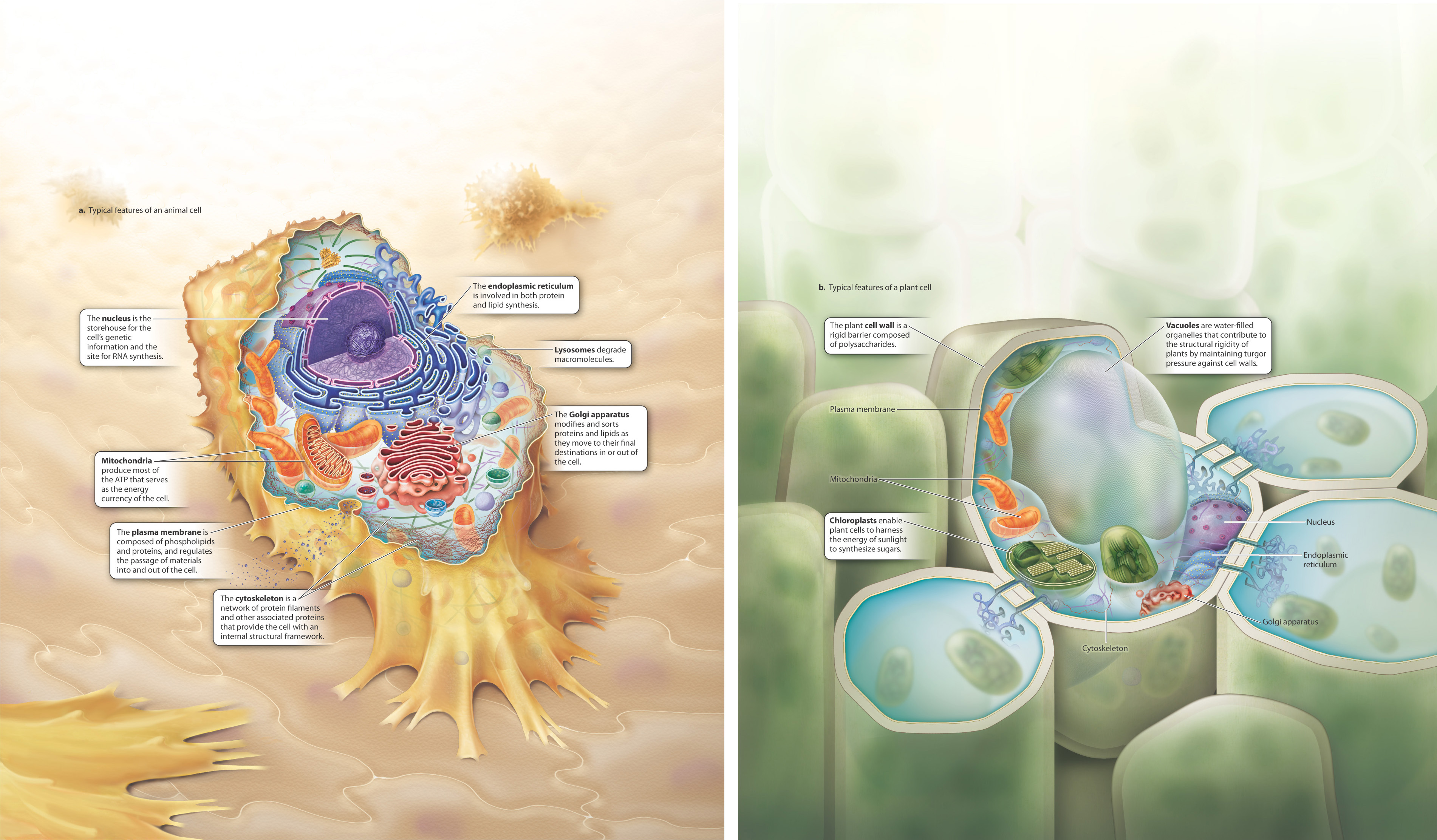CHAPTER SUMMARY
5.1 CELL MEMBRANES ARE COMPOSED OF LIPIDS, PROTEINS, AND CARBOHYDRATES.
- Phospholipids have both hydrophilic and hydrophobic regions. As a result, they spontaneously form structures such as micelles and bilayers when placed in an aqueous environment.
- Membranes are fluid, meaning that membrane components are able to move laterally in the plane of the membrane.
- Membrane fluidity is influenced by length of fatty acid chains, presence of carbon–carbon double bonds in fatty acid chains, and amount of cholesterol.
- Many membranes also contain proteins that span the membrane (transmembrane proteins) or are temporarily associated with one layer of the lipid bilayer (peripheral proteins).
5.2 THE PLASMA MEMBRANE IS A SELECTIVE BARRIER THAT CONTROLS THE MOVEMENT OF MOLECULES BETWEEN THE INSIDE AND OUTSIDE OF THE CELL.
- Selective permeability results from the combination of lipids and proteins that make up cell membranes.
- Passive transport works by diffusion, the random movement of molecules. Net movement of molecules occurs from regions of higher concentration to regions of lower concentration.
- Passive transport can occur directly through the plasma membrane (simple diffusion) or be aided by protein channels (facilitated diffusion).
- Active transport moves molecules from regions of lower concentration to regions of higher concentration and requires energy.
- Primary active transport uses energy stored in ATP; secondary active transport uses the energy stored in an electrochemical gradient.
- Cells maintain size and composition by protein pumps that actively move ions in and out of the cell, contractile vacuoles, and the cell wall.
5.3 CELLS CAN BE CLASSIFIED AS PROKARYOTES OR EUKARYOTES; THESE DIFFER IN THE DEGREE OF INTERNAL COMPARTMENTALIZATION.
- Prokaryotic cells lack a nucleus and other internal membrane-enclosed compartments.
- Prokaryotic cells include bacteria and archaea and are much smaller than eukaryotes.
- Eukaryotic cells have a nucleus and other internal compartments called organelles.
- Eukaryotes include animals, plants, fungi, and protists.
5.4 THE ENDOMEMBRANE SYSTEM IS AN INTERCONNECTED SYSTEM OF MEMBRANES THAT INCLUDES THE NUCLEAR ENVELOPE, ENDOPLASMIC RETICULUM, GOLGI APPARATUS, LYSOSOMES, VESICLES, AND PLASMA MEMBRANE.
- The nucleus, which is enclosed by a double membrane called the nuclear envelope, houses the genome.
- The endoplasmic reticulum is continuous with the outer nuclear envelope and manufactures proteins and lipids for use by the cell or for export out of the cell.
- The Golgi apparatus communicates with the ER via transport vesicles. It receives proteins and lipids from the endoplasmic reticulum and directs them to their final destinations.
- Lysosomes break down macromolecules like proteins to simpler compounds that can be used by the cell.
- Protein sorting directs proteins to their final destinations in or out of the cell.
- Proteins synthesized on free ribosomes are sorted after translation and proteins synthesized on ribosomes associated with the endoplasmic reticulum are sorted during translation.
- Proteins synthesized on free ribososomes are sorted by means of an amino acid sequence known as a signal sequence.
- Proteins synthesized on ribosomes associated with the endoplasmic reticulum have a signal sequence that is recognized by a signal recognition particle (SRP).
5.5 MITOCHONDRIA AND CHLOROPLASTS ARE ORGANELLES INVOLVED IN HARNESSING ENERGY; THEY ARE LIKELY EVOLVED FROM FREE-LIVING PROKARYOTES.
- Mitochondria harness energy from chemical compounds for use by both animal and plant cells.
- Chloroplasts harness the energy of sunlight to build sugars.
Self-Assessment Question 1
Describe how lipids with hydrophilic and hydrophobic regions behave in an aqueous environment.
Show Model Answer
Model Answer:
In an aqueous environment, the polar hydrophilic head group will readily interact with the polar water molecules. In contrast, the nonpolar hydrophobic tail does not readily interact with water and will instead interact with other nonpolar tail groups or hydrophobic molecules. For example, a micelle forms when the polar head group of a lipid interacts with water and the hydrophobic tails of the lipids interact with each other excluding the water. Lipids can also form micelles and liposomes (Figure 5.2).

Self-Assessment Question 2
Describe two ways in which proteins associate with membranes.
Show Model Answer
Model Answer:
Proteins can associate with membranes in the following ways: (1) Integral membrane proteins are permanently associated with the membrane and cannot be removed without destroying the membrane itself. Most integral membrane proteins span the cell membrane, thus they have both hydrophilic and hydrophobic regions. (2) Peripheral membrane proteins are temporarily associated with the membrane and can easily be experimentally separated. These proteins can be associated with either the internal or external side of the membrane. They are mostly hydrophilic in nature and interact with the polar heads of the lipid bilayer, or the hydrophilic regions of integral membrane proteins.
Self-Assessment Question 3
Describe an experiment that demonstrates that proteins move in membranes.
Show Model Answer
Model Answer:
An experiment designed to show that proteins move in membranes is the FRAP technique. FRAP stands for fluorescence recovery after photobleaching. First, the proteins embedded in the cell membrane are labeled with fluorescent dye molecules. A laser is then used to bleach part of the cell, causing it to no longer fluoresce. Eventually, the fluorescently labeled proteins from other parts of the cell will move into the bleached area and cause it to fluoresce once again. If the proteins did not move in membranes, that area would stay bleached for the life of the cell.
Self-Assessment Question 4
Name three parameters that need to be stably maintained inside a cell.
Show Model Answer
Model Answer:
Three parameters that need to be stably maintained inside a cell are pH, salt concentration, and water.
Self-Assessment Question 5
Explain the role of lipids and proteins in maintaining the selective permeability of membranes.
Show Model Answer
Model Answer:
Lipids help maintain the selective permeability of the membrane by preventing charged molecules and ions from diffusing freely into the cell. They also allow molecules like gases and small polar molecules to diffuse freely through the membrane. Large molecules like proteins and polysaccharides are too large to cross the plasma membrane without help so their transport must be facilitated. Proteins in the membrane help with this process by acting as channels and pores that import and export these molecules and others into and out of the cell. Each kind of channel or transporter has a specific kind of molecule, or sometimes a single molecule, that it helps across the membrane, thus adding another layer of specificity.
Self-Assessment Question 6
Distinguish between passive and active transport mechanisms across cell membranes.
Show Model Answer
Model Answer:
Passive transport into and out of cells works through diffusion (the random movement of molecules). When there is a concentration difference (concentration gradient) of a particular molecule across the cell membrane, the molecule will move from the area of higher concentration to the area of lower concentration. Facilitated diffusion happens when a molecule cannot move across the plasma membrane on its own. These molecules passively diffuse through channels or protein carriers in the lipid bilayer (See Figure 5.10). In contrast, active transport is used by the cell to move a molecule into or out of the cell against its concentration gradient. Molecules move through transport proteins (integral membrane proteins) embedded in the cell membrane. This type of transport requires energy, either directly (primary active transport, Figure 5.12) or indirectly (secondary active transport, Figure 5.13).
Self-Assessment Question 7
Describe three different ways in which cells maintain size and composition.
Show Model Answer
Model Answer:
Cells maintain size and composition in the following ways: (1) Cells can use active transport to maintain the intracellular solute concentration so that it equals the extracellular solute concentration. This helps keep water at equilibrium inside and outside of the cell, giving the cell shape (e.g., red blood cell). (2) The cell wall of some organisms help maintain the cell’s size and shape by providing a rigid structure surrounding the cell membrane. (3) Single celled organisms contain a contractile vacuole that take up excess water inside the cell and expel it through contracting. This helps maintain the composition and size of the organism.
Self-Assessment Question 8
Compare the organization, degree of compartmentalization, and size of prokaryotic and eukaryotic cells.
Show Model Answer
Model Answer:
Prokaryotic cells lack a nucleus and extensive internal compartmentalization. They contain plasmids that carry additional genes that can be transferred to other bacteria. Prokaryotic cells are also small (usually 1–2 micrometers in diameter or smaller). Their small size allows for a greater surface area-to-volume ratio for the cell and thus a better-suited membrane for the absorption of nutrients in the environment. Eukaryotic cells, on the other hand, have a nucleus and have specialized internal structures called organelles. They are also 10 times larger in diameter and 1000 times larger in volume than a prokaryotic cell.
Self-Assessment Question 9
Name the major organelles in eukaryotic cells and describe their functions.
Show Model Answer
Model Answer:
See Figure 5.17 for a brief synopsis.

Self-Assessment Question 10
Explain how a protein ends up in the cytosol, in the plasma membrane, or secreted from the cell.
Show Model Answer
Model Answer:
Proteins produced on free ribosomes in the cytosol are typically directed to their final destination through particular amino acid sequences called signal sequences. These proteins are sorted after they have been translated. Some compartments of the cell (the nucleus, mitochondria, and chloroplasts) have different signal sequences associated with them (e.g., nuclear localization signals will direct the protein to the nucleus). Proteins with no signal sequence remain in the cytosol. Proteins produced by ribosomes on the rough endoplasmic reticulum end up in the lumen of the endomembrane system or embedded in its membrane. They may also be secreted out of the cell. These proteins are sorted as they are translated. They are initially translated by a ribosome in the cytosol, but a signal sequence in the growing protein directs the ribosome to a channel on the rough ER. As the protein is translated it is threaded through the channel. These proteins are destined for the ER lumen, Golgi apparatus, lysosomes, or for secretion outside the cell. If the protein contains an additional signal sequence called a signal anchor sequence, it will remain in the ER membrane as it is synthesized, rather than passing entirely into the ER lumen.